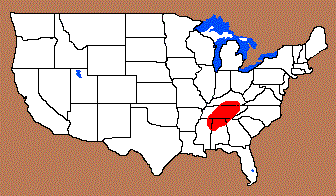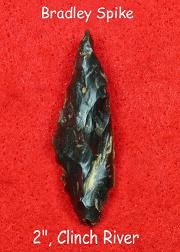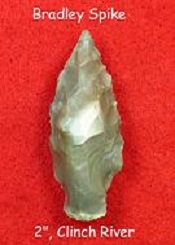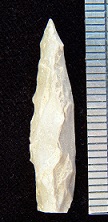Outline is Representative of Size and Shape:

Name Details:
Identified By: Madeline Kneberg
Named For: County in Tennessee
Date Identified: 1956
Type Site:
Identified By: Madeline Kneberg
Named For: County in Tennessee
Date Identified: 1956
Type Site:
Point Validity:
Valid type
Kneberg was a prominent anthropologist and professor at the University of Tennessee. She is most recognized for her excavations through-out the Tennessee River Valley. This type was named in a professional publication and has many professional references. This is considered a valid type.
Kneberg was a prominent anthropologist and professor at the University of Tennessee. She is most recognized for her excavations through-out the Tennessee River Valley. This type was named in a professional publication and has many professional references. This is considered a valid type.
Bradley Spike
Cluster: Woodland Spike Cluster Description of Physical Characteristics and Flaking Pattern:
This is a small to medium thick narrow stemmed point. The cross section is primarily elliptical, but may also have a medial ridge or in some thicker examples may almost be round. The blade may range from excurvate to straight. The shoulders are weak and are angled upwards. The stem is primarily straight; slightly expanding to contracting stems may also be seen. The base ranges from straight to convex and may be unfinished, have basal grinding, or thinning. This point has a random flaking pattern.
Size Measurements:
Length - 40 to 65 mm (51 mm average), Stem Length - 7 to 15 mm (11 mm average), Blade Width - 10 to 17 mm (15 mm average), Stem Width -8 to 11 mm (10 mm average), Thickness - 6 to 14 mm
Length - 40 to 65 mm (51 mm average), Stem Length - 7 to 15 mm (11 mm average), Blade Width - 10 to 17 mm (15 mm average), Stem Width -8 to 11 mm (10 mm average), Thickness - 6 to 14 mm
Commonly Utilized Material:
Additional Comments:
Schroder (W18) notes the difference between the spike type points found in Georgia and Florida. He points out that the Bradley Spike has a stem that varies from straight to contracting with a pointed base. The Duval point has a straight to bulbous style stem. The Flint River point has a rounded stem. The New Market point has a contracting stem. The Schild point has a short straight to slightly expanding stem, and the Florida Spike has a straight to contracting stem with a straight base. The name Woodland Spike was a term used by Whatley that lumped all the Woodland period spike type points into a single category. Farr credits Whatley for the term Woodland Spike while Schroder credits Jerald Ledbetter for the name.
Schroder (W18) notes the difference between the spike type points found in Georgia and Florida. He points out that the Bradley Spike has a stem that varies from straight to contracting with a pointed base. The Duval point has a straight to bulbous style stem. The Flint River point has a rounded stem. The New Market point has a contracting stem. The Schild point has a short straight to slightly expanding stem, and the Florida Spike has a straight to contracting stem with a straight base. The name Woodland Spike was a term used by Whatley that lumped all the Woodland period spike type points into a single category. Farr credits Whatley for the term Woodland Spike while Schroder credits Jerald Ledbetter for the name.
Distribution:

Distribution Comments:
These points are primarily found in the Tennessee River Valley and surrounding areas
These points are primarily found in the Tennessee River Valley and surrounding areas
Age / Periods:
Date: 4,000 - 1,800 B.P.
Cultural Period: Late Archaic to Early Woodland
Glacial Period: Neoglacial to Roman Warm
Culture:
Date: 4,000 - 1,800 B.P.
Cultural Period: Late Archaic to Early Woodland
Glacial Period: Neoglacial to Roman Warm
Culture:
Age Details:
Similar Points:
Briar Creek, Buggs Island, Collins, Flint River Spike, Guilford Stemmed, Mountain Fork, New Market
Briar Creek, Buggs Island, Collins, Flint River Spike, Guilford Stemmed, Mountain Fork, New Market
Other points in this cluster / Related / Associated Points:
Duval, Flint River, Florida Spike, New Market, Schild
Duval, Flint River, Florida Spike, New Market, Schild




